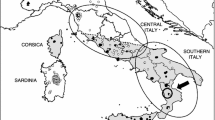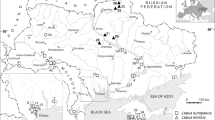Abstract
Denmark lies on the edge of the distributional range of the brown hareLepus europaeus Pallas, 1778, where population differentiation is most likely to occur. A total of 369 brown hares from eight geographically distinct Danish European brown hare populations were used to study the genetic population structure. In all, 480bp of the mitochondrial D-loop were sequenced in both directions. Observed genetic diversity (π) was relatively low (π=0.41%) while haplotype diversity (h=0.808) and the number of unique haplotypes (19) were similar to levels found in other European brown hare populations. The observed population structure was pronounced (pairwise conventionalF ST and ϕ st ranged between 6.9–57% and 5–69.8%, respectively). There was no correlation between the geographic and the genetic distance. Population structure was influenced by genetic drift, anthropogenic effects (eg translocation and escapes from hare-farms) and by post-glacial recolonization from southern refuges or refuges north east of the Black Sea. Analysis of historical population expansion/fluctuation events indicated that the populations have experienced different demographic events in the recent past. Relatively high sequence divergence between some populations might be explained by multiple recolonization events after the last Pleistocene glaciations or by stocking effects. Colonization from southern refuges was supported by the observation that haplotype 2 in the Danish brown hare was identical to the central European ancestral haplotype c07.
Similar content being viewed by others
References
Bekkevold D., Hansen M. M. and Nielsen E. E. 2006. Genetic impact of gadoid culture on wild fish populations: predictions, lessons from salmonids, and possibilities for minimizing adverse effects. ICES J. Marine Science 63: 198–208.
Bijlsma R., Bundgaard J. and Boerema A. C. 2000. Does inbreeding affect the extinction risk of small populations?: Predictions fromDrosophila. Journal of Evolutionary Biology 13: 502–514.
Bray Y., Devillard S., Marboutin E., Mauvy B. and Péroux R. 2007. Natal dispersal of European hare in France. Journal of Zoology, London 273: 427–434.
Bray Y., Marboutín E., Mauvy B. and Péroux R. 2004. La dispersion natale chez liévre d’Europe: mise en évidence et quantification du phénomène. ONCFS Rapport scientifique 2004: 42–49.
Brown J. H. 1984. On the relationship between abundance and distribution of species. The American Naturalist 124: 255–279.
Brown J. and Kodric-Brown A. 1977. Turnover rates in insular biogeography: effect of immigration and extinction. Ecology 58: 445–449.
Chepko-Sade B. D. and Halpin Z. T. 1987. Mammalian dispersal patterns: The effects of social structure on population genetics. University of Chicago Press, Chicago: 1–360.
Clement M., Poseda D. and Crandall K. A. 2000. TCS: a computer program to estimate gene genealogies. Molecular Ecology 9: 1657–1660.
Felsenstein J. 2004. Inferring phylogenies. Sinauer Associates, Sunderland, Massachusetts: 73–96.
Fickel J., Hauffe H. C., Pecchiolo E., Soriguer R., Vapa L. and Pitra C. 2008. Cladogenesis of the European brown hare (Lepus europaeus Pallas, 1778). European Journal of Wildlife Research (doi:10.1007/s10344-008-0175-x).
Fickel J., Schmidt A., Putze M., Spittler H., Ludwig A., Streich W. J. and Pitra C. 2005. Genetic structure of populations of European brown hare: implications for management. The Journal of Wildlife Management 69: 760–770.
Flux J. E. C. 1983. Introduction to taxonomic problems in hares. Acta Zoologica Fennica 174: 7–10.
Fredsted T., Wincentz T., Villesen P. 2006. Introgression of mountain hare (Lepus timidus) Mitochondrial DNA into wild brown hares (Lepus europaeus) in Denmark. BMC Ecology 6: 17.
Fu Y. X. 1997. Statistical neutrality of mutations against population growth, hitchhiking a and background selection. Genetics 147: 915–925.
Fu Y. X. and Li W. H. 1993. Statistical tests of neutrality of mutations. Genetics 133: 693–709.
Gerloff U., Hartung B., Fruth B., Hohmann G. and Tautz D. 1999. Intracommunity relationships, dispersal pattern and paternity success in a wild living community of Bonobos (Pan paniscus) determined from DNA analysis of faecal samples. Proceedings Royal Society B. 266: 1189–1195.
Hall T. 1999. BioEdit: a user-friendly biological sequence alignment editor and analysis program for Windows 95/98/NT. Nucleic Acid Symposium 41: 95–98.
Hansen K., Jørgensen A. and Henriksen P. 1990. [The brown hare in nature, farm animal, diseases]. Jordbrugsforlaget, Det kgl. danske Landhusholdningsselskab: 1–125. [In Danish]
Hewitt G. M. 1999. Post-glacial re-colonization of European biota. Biological Journal of the Linnean Society 68: 87–112.
Johnson J. A., Dunn P. O. and Bouzat J. L. 2007. Effects of recent population bottlenecks on reconstructing the demographic history of prairie-chickens. Molecular Ecology 16: 2203–2222.
Kasapidis P., Suchentrunk F., Magoulas A. and Kotoulas G. 2005. The shaping of mitochondrial DNA phylogeographic patterns of the brown hare (Lepus europaeus) under the combined influence of Late Pleistocene climatic fluctuations and anthropogenic translocations. Molecular Phylogenetics and Evolution 34: 55–66.
Kirkpatrick M. and Barton N. H. 1997. Evolution of a species’ range. The American Naturalist 150: 1–23.
Kleist M. H. 1995. [The brown hare]. Natur og Museum 34, Drgang 1: 1–31. [In Danish]
Luikart G., Giellly L., Excoffier L., Vigne J. D., Bouuvet J. and Taberlet P. 2001. Multiple maternal origins and weak phylogeographic structure in domestic goats. Proceedings of the National Academy of Sciences USA 98: 5927–5932.
Mamuris Z., Sfougaris A. I. and Stamatis C. 2001. Genetic structure of Greek brown hare (Lepus europaeus) populations as revealed by mtDBNA RFLP-PCR abalysis: implications for conserving genetic diversity. Biological Conservation 101: 187–196.
Matocq M. D., Patton J. L. and Da Silva M. N. F. 2000. Population genetic structure of two ecologically distinct Amazonian spiny rats: separating history and current ecology. Evolution 54: 1423–1432.
Nei M. 1978. Estimation of average heterozygosity and genetic distance from a small number of individuals. Genetics 89: 583–590.
Panek M. and Kamieniarz R. 1999. Relationships between density of brown hareLepus Europeaus and landscape structure in the years 1981–1995. Acta Theriologica 44: 67–75.
Pierpaoli M., Riga F., Trocchi V. and Randi E. 1999. Species distinction and evolutionary relationship of the Italian hare (Lepus corsicanus) as described by mitochondrial DNA sequencing. Molecular Ecology 8: 1805–1817.
Ray C. 2001. Maintaining genetic diversity despite local extinctions: effects of population scale. Biological Conservation 100: 3–14.
Rice W. R. 1989. Analysing tables of statistical tests. Evolution 43: 223–225.
Richards C. 2000. Inbreeding depression and genetic rescue in a plant metapopulation. The American Naturalist 155: 383–394.
Rogers A. R. and Harpending H. 1992. Population growth makes waves in the distribution of pairwise genetic differences. Molecular Biology and Evolution 9: 552–569.
Ryman N., Jorde P. E. and Laikre L. 1995. Supportive breeding and variance effective population size. Conservation Biology 9: 1619–1628.
Saccheri I. and Brakefield P. 2002. Rapid spread of immigrant genomes into inbred populations. Proceedings of the Royal Society B. 269: 1073–1078.
Sagarin R. and Gaines S. 2002. The ‘abundance centre’ distribution: to what extent is it a biogeographic rule? Ecology Letters 5: 137–147.
Schneider S., Kueffer J. M., Roessli D. and Excoffier L. 2000. ARLEQUIN: a software package for population genetics. Geneve: Genetics and Biometry Lab, Department of Anthropology, University of Geneve. http://an_ Hlt1362895t_Hlt1362895hropologie.unige.ch/arlequin
Schwartz M. K., Mills L. S., Ortega Y., Ruggiero L. F. and Allendorf F. 2003. Landscape location effects genetic variation of Canada Lynx (Lynx canadensis). Molecular Ecology 12: 1807–1810.
Slatkin M. and Hudson R. R. 1991. Pairwise comparisons of mitochondrial DNA sequences in stable and exponentially growing populations. Genetics 129: 555–562.
Smith R. K., Jennings N. V., Robinson A. and Harris S. 2004. Conservation of European hares (Lepus europaeus) in Britain: is increasing habitat heterogeneity in farmland the answer? Journal of Applied Ecology 41: 1092–1102.
Smith R., Vaughan N. and Harris S. 2005. A quantitative analysis of the abundance and demography of European hares (Lepus europaeus) in relation to habitat type, intensity of agriculture and climate. Mammal Review 35: 1–24.
Tajima F. 1989. Statistical methods to test for nucleotide mutation hypothesis by DNA polymorphism. Genetics 123: 585–595.
Tamura K. and Nei M. 1993. Estimation of the number of nucleotide substitutions in the control region of mitochondrial DNA in humans and chimpanzees. Molecular Biology and Evolution 10: 512–526.
Tapper S. and Parsons N. 1984. The changing status of the brown hare (Lepus capensis L.) in Britain. Mammal Review 14: 57–70.
Templeton A. R., Crandall K. A. and Sing C. F. 1992. A cladistic analysis of phenotypic associations with haplotypes inferred from restriction endonuclease mapping and DNA sequence data. III. Cladogram estimation. Genetics 132: 619–633.
Thulin C.-G. 2003. The distribution of mountain hares (Lepus timidus, L 1758) in Europe: a challenge from brown hares (L. europaeus, Pall. 1778)? Mammal Review 33: 29–42.
Thulin C.-G. and Tegelström H. 2002. Biased geographical distribution of mitochondrial DNA that passed the species barrier from mountain hares to brown hares (genus:Lepus): an effect of genetic incompability and mating behaviour? Journal of Zoology, London 258: 299–306.
Thulin C.-G., Isaksson M. and Tegelström H. 1997. The origin of Scandinavian mountain hares (Lepus timidus). Gibier Faune Savage 14: 463–475.
Trizio I., Crestanello B., Galbusera P., Wauters L. A., Tosi G., Matthysen E. and Hauffe H. C. 2005. Geographical distance and physical barriers shape the genetic structure of Eurasian red squirrels (Sciurus vulgaris) in the Italian Alps. Molecular Ecology 14: 469–481.
Villesen P. 2007. FaBox: an online toolbox for fasta sequences. Molecular Ecology Notes 7: 965–968.
Walsh P. S., Metzger D. A. and Higuchi R. 1991. Chelex 100 as a medium for simple extraction of DNA for PCR-based typing from forensic material. Biotechniques 10: 506–513.
Wasilewski M. 1991. Population dynamics of the brown hareLepus europaeus Pallas, 1778 in central Poland. Acta Theriologica 36: 267–274.
Wright S. 1951. The genetical structure of populations. Annals of Eugenics 15: 323–354.
Author information
Authors and Affiliations
Corresponding author
Additional information
Associate editor was Magdalena Niedziałkowska.
Rights and permissions
About this article
Cite this article
Andersen, L.W., Fredsted, T., Wincentz, T. et al. Brown hares on the edge: Genetic population structure of the Danish brown hare. Acta Theriol 54, 97–110 (2009). https://doi.org/10.1007/BF03193166
Received:
Accepted:
Issue Date:
DOI: https://doi.org/10.1007/BF03193166




